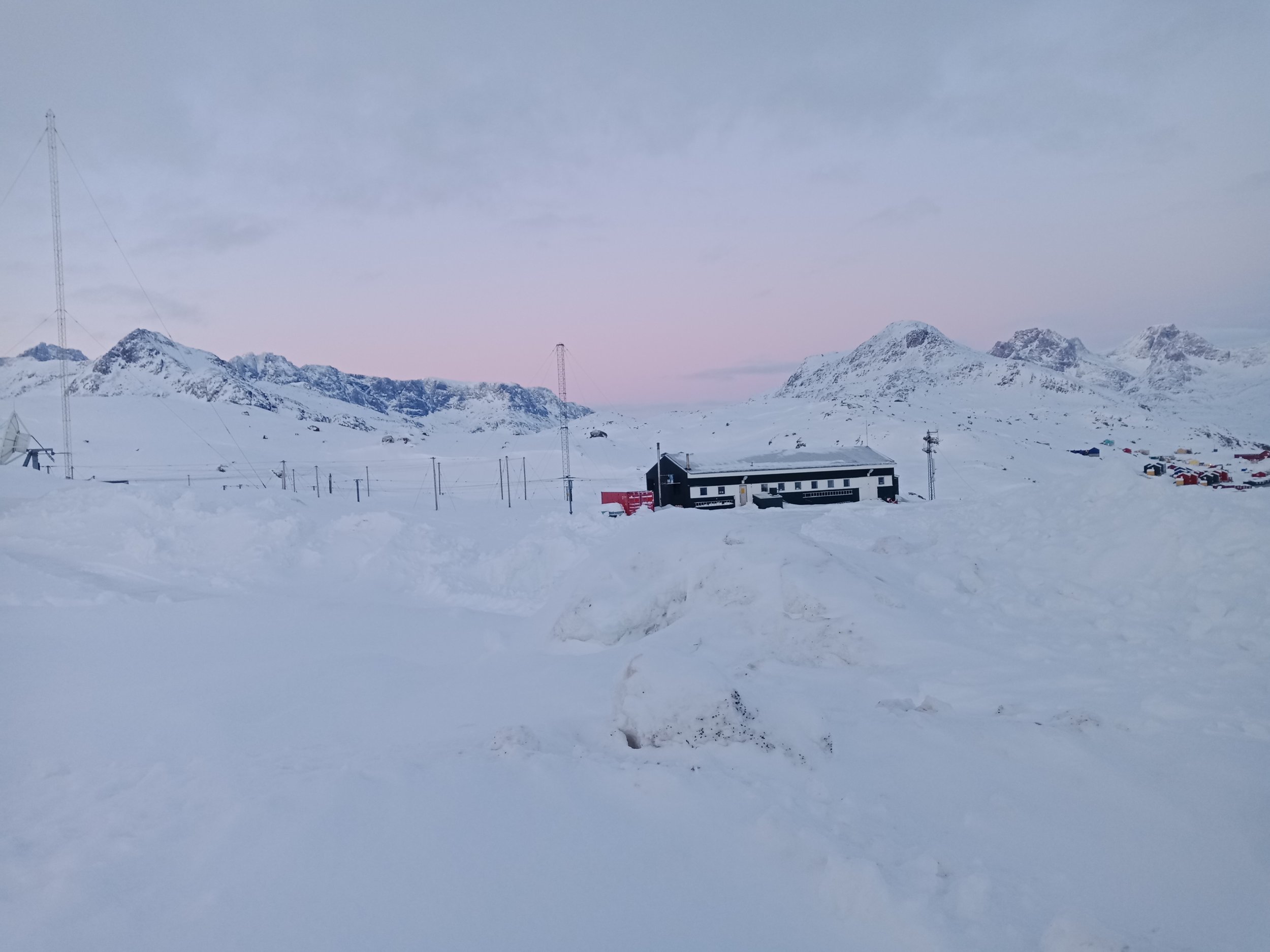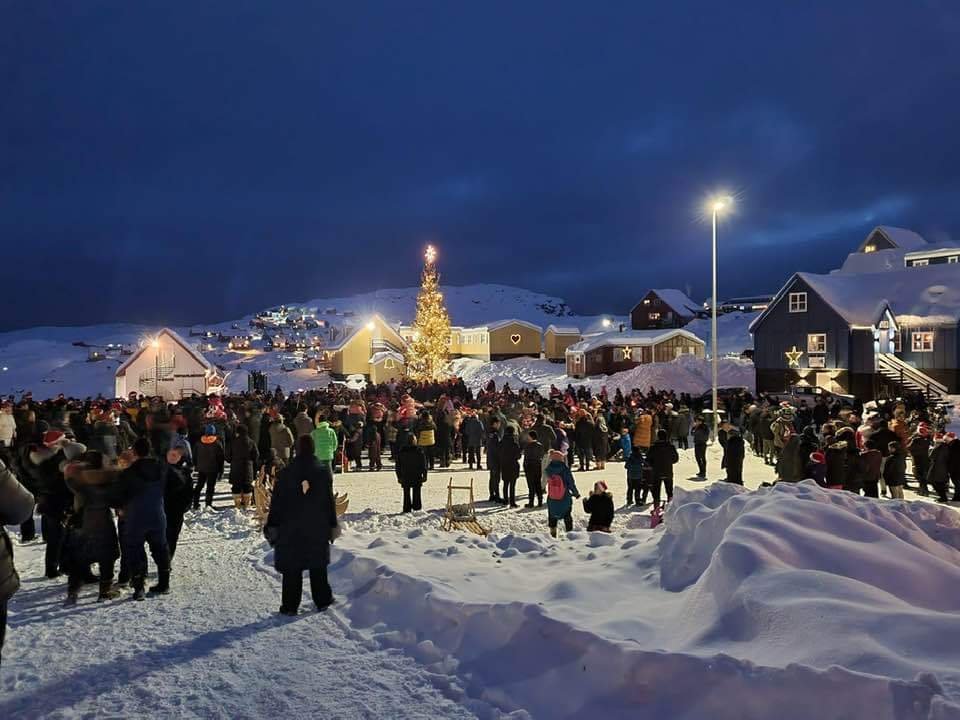Into the snowy realm
Snow2Rain fieldwork report from Tasiilaq, East Greenland (Part I)In our collaboration, we bring together the disciplines of anthropology and snow climatology for the benefit of the local people in Tasiilaq, East Greenland. We explore how the qualities of social and natural sciences can create new and different types of knowledge on environmental change. This field report comes in three parts: Part I sets the scene of our research project whereas part II and part III are dedicated to our individual perspectives on the time we spent together in Tasiilaq.
Snow2Rain project logo designed by Mark Nielsen Outridge.
From snow to rain
Arriving in the midst of winter, we, Anna and Jorrit, finally started our fieldwork for the interdisciplinary research project called Snow2Rain in November 2021. The project name from snow to rain, or Snow2Rain, reflects the expected future change from snowfall to more rainfall in Greenland. This predicted change is also reflected in the Snow2Rain project logo, representing the phase transition from snow to rain which scientists outline for the Arctic Region based on climate modelling.
Rainy day in Tasiilaq in December 2021.
Tasiilaq is located in a region in Greenland that usually gets high amounts of precipitation every year. Due to climate change, temperatures are rising across the globe and especially in the Arctic region. In Greenland, the higher temperatures lead to less sea ice and more evaporation of ocean water. The evaporated water will eventually fall down, and when it does, it is increasingly likely that it will fall as rain, due to the expected higher temperatures. Hence, it is expected that the snowfall amount will decrease and that there will be more rain in the future. Our project wants to understand this transition from snow to rain and how this is influencing the quality of life in Tasiilaq. We use physical snow measurements and data from climate models and combine these with local expertise on the topic of snow and rain. As an example of physical snow measurements, we are operating a snow sensor that automatically measures the density of the snow that accumulates above it and additionally we are performing manual measurements of snow height and snow density. With our approach, we hope to better understand the challenges of living with these expected changes in the environment and benefit the residents in Tasiilaq.
Tasiilaq, East Greenland
Tasiilaq, which means ‘the place with a lake’ because of the shape of the fjord, is the biggest town on the East coast of Greenland, with about 1.900 inhabitants. The town is located on Ammassalik island. What is often referred to as a remote, harsh and isolated place, reveals itself as a scenic view of gradual hills, steep mountains, deep fjords, and in the summer valleys of flowers that are for now covered in thick layers of snow.
This map shows the area of Ammassalik Island, where Tasiilaq is located. In the top right corner, you can see overall Greenland, and the area marked in red is the location of Ammassalik island.
Background information on the research station: The research station close to Mittivakkat glacier is a base for scientists who perform research in the Ammassalik region. Some examples of research activities are: maintaining the weather stations on Mittivakkat, performing snow measurements and measuring the amount of water that comes from the glacier. Anna heading towards the helicopter for the last part of the journey to Tasiilaq.
Our long journey began in Copenhagen with a flight to Kangerlussuaq with the Airbus 330-200, from where we continued to Nuuk later that same day with a Dash-8-200. While at least one overnight stay is necessary, we extended this stopover to participate in the Greenland Science Week. Adding to the Greenland experience, our flight got delayed due to stormy weather. After two days of delay, or after another two days we got to enjoy ourselves in Nuuk, we proceeded to Kulusuk with a Dash-8-200 and finally arrived in Tasiilaq after a 10-minute scenery helicopter flight on a Bell 212. Aircrafts, apart from boats, are the main type of transportation, and for long distances the only mode of connectivity. To us, all these legs up in the air felt more like a wonderful sightseeing experience; we were lucky to grab window seats and glance at this huge snow-covered and icy island from above.
Here we are, finally in Tasiilaq, a year of preparation, thoughts, discussions of approaches in our backpacks and yet we find ourselves where it all started and what seems to be the most essential question: ‘what do we do?’ Soon we were to find out that we had very different expectations and ideas about the four weeks ahead of us. What has brought us together is communication, learning about the other discipline in practice, teaching about one's own discipline, outlining differences and similarities to create a balance on what is possible and what not.
Interdisciplinary research - a collaboration of natural sciences, social sciences and the people from Tasiilaq
It is an interdisciplinary research project of climatology and anthropology engaging in a collaboration with the residents of Tasiilaq. Right from the start, there were many things happening at once, plenty of new impressions, and yet ‘taking our time’ has proven as one of the most important assets while initiating a collaboration with the local community in Tasiilaq. Figuring out the rhythm of everyday life in Tasiilaq, e.g. how to approach people or how to stay informed about happenings in town, takes good observation skills and willingness to be proactive and flexible.
The setting of our project provides for a unique situation that brings together collecting snow data and ethnographic fieldwork. Due to the small project team, the anthropologist supports the snow climatologist in measurements and the snow climatologist gets insights into what ethnographic fieldwork means and how it benefits the research project. We are two PhD students at the beginning of our scientific careers that build our own disciplines while at the same time emerging into another discipline. Gathering data with an ethnographic fieldwork approach is done by using observational and conversational techniques, as well as written accounts. The main focus is on the researcher’s interaction with people in their environment by becoming part of this everyday life themselves. In our context this included for example, playing at the weekly badminton session, participating in chess club, listening to choir practice, going to happenings in Tasiilaq like a local concert or the lighting of the Christmas tree or offering activities such as Christmas baking afternoon for young adults. This approach allows us to identify local processes where our research fits, where local concerns overlap with our research, in order to add value to local happenings. From day one, we have been welcomed by the friendly people in Tasiilaq. Even with the instalment of the sensor we have been able to engage with some people, who were very curious to learn more about our research. We have been fortunate to receive help whenever necessary to enable us to navigate in a, for us, new environment. For example, with the setup of the snow sensor, from finding a location, to the instalment and putting it into operation, as well as occurring problems with the function of the sensor. We are continuously offered support and assistance with routine tasks and challenges.
Why is taking time so valuable? Because we do not want to invade the place, we are trying to enter a small local society. Spending time with people and being part of everyday life allows us to understand the complexity of life in Tasiilaq and identify where our research can become valuable for the people involved. After all, it is the researcher behind the project, as human beings, the locals are engaging with. This may be while greeting people on the street, during meetings, informal conversations or unexpected encounters.
Now that we have set the scene together, let’s explore our individual perspectives on the four weeks that we spent together in Tasiilaq. This is the beginning of our journey, an intermediate status on initiating a collaboration. The Snow2Rain project, funded by the Austrian Academy of Sciences, runs until mid of 2023.
The faces behind Snow2Rain - Anna Burdenski und Jorrit van der Schot.
Written by Anna Burdenski and Jorrit van der Schot
© Photos by Anna Burdenski and Jorrit van der Schot
Written in collaboration with APRI, the Austrian Polar Research Institute.










